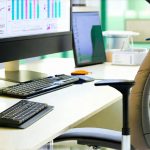Prolonged sitting has become an almost unavoidable aspect of modern work life for many. While seemingly innocuous, extended periods in a seated position can contribute to a range of physical discomforts and even long-term health concerns. However, the issue isn’t simply how much we sit, but also the way we sit, and the environments that encourage unhealthy postures and limited movement. Recognizing these “sitting triggers” – those factors in our workspace or habits that promote static posture and discourage activity – is the first step towards mitigating their impact. This article will explore practical strategies for identifying and avoiding sitting triggers at work, helping you cultivate a more comfortable, productive, and healthier workday.
Many individuals underestimate the cumulative effect of seemingly small postural issues throughout the day. A slightly incorrect chair height, an improperly positioned monitor, or even habitual slouching can all contribute to muscle strain, fatigue, and ultimately, discomfort. It’s also important to remember that sitting isn’t inherently bad; it’s prolonged static sitting that poses a problem. The key is to disrupt the pattern of continuous seated posture with regular movement and mindful adjustments to our work environment and habits. This isn’t about eliminating sitting altogether—for many jobs that’s unrealistic—but about minimizing its negative impact through proactive strategies.
Understanding Your Personal Sitting Triggers
Identifying your individual triggers is paramount. What specifically leads you to adopt poor postures or remain seated for extended periods? It’s not a one-size-fits-all situation; triggers vary significantly based on job roles, office setups, and personal habits. Consider these common culprits: – Lack of ergonomic assessment of your workstation – Uncomfortable chair lacking adequate support – Monitor positioned incorrectly causing neck strain – Work tasks requiring intense focus leading to prolonged stillness – Social pressures or workplace culture discouraging breaks – feeling you must always appear busy.
Beyond the physical environment, internal factors play a significant role. Stress and anxiety can lead to muscle tension and subconscious postural changes like hunching shoulders or clenching jaws, exacerbating discomfort. Similarly, habits developed over time—perhaps leaning forward while typing or crossing your legs—can become deeply ingrained and difficult to break without conscious effort. Paying attention to when you feel most uncomfortable or fatigued during the workday can provide valuable clues about your specific triggers. Are you more likely to slouch after lunch? Do you experience neck pain during video calls? These observations are crucial for tailoring solutions to your needs.
Finally, don’t underestimate the power of routine. Many people fall into patterns where they sit through entire meetings without moving or remain glued to their screens during breaks, scrolling social media instead of taking a walk. Recognizing these habitual behaviors allows you to actively intervene and create space for movement and postural changes throughout your day. A simple self-assessment – noting down when and why you feel most static—can be incredibly insightful.
Proactive Strategies for Minimizing Sitting Time
Once you’ve identified your triggers, the next step is to implement proactive strategies to counteract them. This involves both modifying your workstation and incorporating movement into your daily routine. Start with ergonomics: ensure your chair provides adequate lumbar support, is adjustable in height and tilt, and allows your feet to rest flat on the floor (or a footrest). Position your monitor at arm’s length and eye level to minimize neck strain; consider using a laptop stand if necessary. Keyboard and mouse should be positioned to promote relaxed shoulders and wrists.
Beyond workstation adjustments, actively schedule breaks throughout the day. Short, frequent breaks are more effective than long, infrequent ones. Set reminders on your phone or computer to get up and move every 30-60 minutes – even a quick stretch or walk around the office can make a significant difference. Integrate movement into your workflow: take walking meetings, stand while talking on the phone, or use a standing desk for portions of the day. The goal isn’t necessarily to eliminate sitting entirely, but to break up prolonged static posture with regular activity.
Consider exploring alternative work arrangements if possible. Can you negotiate flexible working hours that allow you to commute during off-peak times and incorporate physical activity into your journey? Could you explore options for remote work or a hybrid model that allows you more control over your environment and routine? These changes, even small ones, can have a cumulative impact on your well-being and productivity.
Implementing Micro-Movements
Micro-movements are subtle adjustments to posture and position that can prevent stiffness and discomfort without disrupting workflow. They’re about adding tiny bursts of activity throughout the day. – Dynamic Sitting: Even while seated, you can engage in small movements like shifting your weight, subtly adjusting your back support, or rotating your ankles. These seemingly insignificant actions help maintain circulation and prevent muscle fatigue. – Posture Checks: Regularly (every 20-30 minutes) consciously scan your body for tension. Are your shoulders rounded? Is your neck strained? Gently readjust your posture to align with ergonomic principles.
These micro-movements aren’t about performing elaborate exercises; they are about avoiding the prolonged static state that is detrimental to comfort and health. Think of it as “active sitting,” a continuous process of subtle adjustments and movements rather than remaining rigidly fixed in one position. It requires mindfulness and consistent effort, but the rewards – reduced discomfort, improved focus, and increased energy levels – are well worth the investment.
Leveraging Technology for Reminders and Support
Technology can be a powerful ally in combating sitting triggers. Numerous apps and devices are available to help you track your sitting time, remind you to take breaks, and even guide you through simple stretches or exercises. – Stand-up Desk Converters: These allow you to easily transition between sitting and standing without replacing your existing desk. – Wearable Fitness Trackers: Many trackers include features that monitor sedentary behavior and provide reminders to move. – Break Reminder Apps: Numerous apps are designed specifically to remind you to take breaks, stretch, or perform simple exercises throughout the day.
Furthermore, consider using voice assistants (like Siri or Google Assistant) to set regular reminders for posture checks or movement breaks. Some productivity tools also integrate features that encourage mindful work habits and prevent burnout. Don’t hesitate to explore these technological solutions – they can provide valuable support in breaking down ingrained sitting patterns. It’s important to find what works best for you, as not all technologies are created equal.
Building a Supportive Workplace Culture
Individual efforts are crucial, but creating a supportive workplace culture is essential for long-term success. Encourage colleagues to take breaks and prioritize ergonomic setups. Advocate for company policies that promote well-being and discourage presenteeism (the practice of coming to work even when ill). – Team Challenges: Organize team challenges focused on movement or healthy habits – steps competitions, lunchtime walks, etc. – Ergonomic Assessments: Encourage your employer to provide regular ergonomic assessments for all employees. – Flexible Work Options: Advocate for flexible work arrangements that allow employees more control over their schedules and environments.
A culture that values well-being fosters a more productive and engaged workforce. By normalizing movement and prioritizing ergonomic health, you can create a workplace where everyone feels empowered to take care of themselves and avoid the pitfalls of prolonged sitting. This is not just about individual comfort; it’s about building a healthier and more sustainable work environment for all.





















